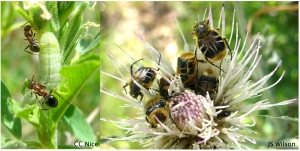Do you like trying new food items? I do. And many herbivore insects seem to do so as well. Invading alien species, yummy yummy! How these interactions affect the ecology of the invaders is studied by Matthew L. Forrister and Joseph S. Wilson in “The population ecology of novel plant–herbivore interactions”. Here’s their background to the study:
Everyone knows that weeds are everywhere these days, and most ecologists know that native insects often like to eat exotic plants. That dynamic (native herbivores utilizing novel hosts) has been very productive for evolutionary biologists (think about the apple maggot fly on apple or the soapberry bug on goldenrain trees), and has become increasingly useful for ecologists who realize that we can watch novel interactions and communities assemble before our eyes.
The ubiquity of interactions between native herbivores and novel plants has led to an imbalance in the ratio of empirical to theoretical work. Moreover, some of the relevant theoretical work (for example on the evolution of niche width) is not always accessible to the average field biologist observing caterpillars eating weeds. Our motivation in writing this paper was to provide an easily accessible conceptual framework that might serve to organize and focus experimental approaches. For example, studies are often reported in which the “preference-performance” relationship is examined using native insects reared on native and exotic hosts. We believe that the focus on that particular relationship demonstrates a certain inertia in the literature that should be overcome, because (for one thing) a rather definitive meta-analysis of that issue has been recently published (Gripenberg et al. 2010 Ecology Letters 13:383-393), and moreover there are many other facets of insect life history that need to be studied, such as interactions with natural enemies, indirect interactions with other herbivores or behavioral factors that affect realized fecundity.
In addition to making the rather fundamental point that our studies need to go beyond the performance of juvenile herbivores and the preference of ovipositing females, we offer some hypotheses to challenge assumptions and spur future work. We present our hypotheses in qualitative, graphical format in the spirit of the late Robert MacArthur. Some quantitatively-sophisticated readers might find this approach simplistic, but we hope that other readers will find it useful. For example, we ask about the shape of the relationship between dispersal ability, population growth rate on a novel host, and the rate at which a new host is utilized. Also in the spirit of MacArthur, we hope that other researchers will be inspired to propose alternative hypotheses, which is something that we believe the graphical (as opposed to verbal) format encourages.



Leave a comment